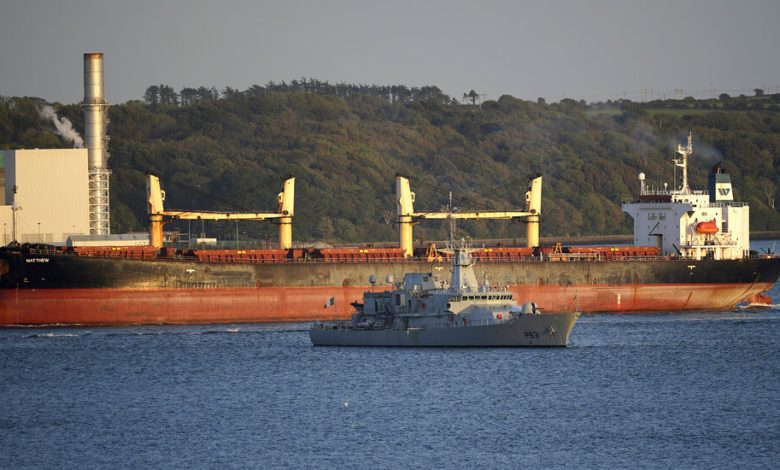Yeats and Beckett, Guarding the Irish Coast

Ireland is proud of its celebrated writers, particularly W.B. Yeats, the vaunted poet who grew up partly in Sligo, a rugged, rural West Coast county that treasures its enduring role as Yeats Country.
You can stop in at WB’s Coffee House on Stephen Street in Sligo town or the nearby Yeats Society for a poetry reading. You can hike the Yeats Trail and stop by the poet’s modest grave at Drumcliffe Church.
So it was notable one morning last month when The Irish Times reported the biggest drug raid in Irish history had been carried out by — who else? — William Butler Yeats.
Not the poet himself, of course, who died in 1939, but his namesake, a 300-foot-long warship.
It was a reminder that the Irish Navy, to the delight of some and the scorn of others, has been naming ships in its small fleet after Irish writers for nearly a decade.
The renewed attention came on Sept. 26, when a cargo ship from South America carrying more than two tons of cocaine appeared, as the poet once wrote, on “the white breast of the dim sea.”
Warning shots from the Yeats helped stop the cargo ship, allowing Army Rangers to board and pull off a dramatic seizure of drugs worth more than $160 million.
While the authorities hailed the raid as a sign of their coastal patrol prowess, some questioned whether a tiny navy with ships named after Irish poets and writers can adequately stop drug running along the coast. (“Gonna Need Bigger and More Boats,” The Irish Echo said in an editorial.)
It has not helped matters that the navy’s ranks have thinned to the point that it can now support patrols by only two major vessels: the Yeats and the Samuel Beckett, named after the absurdist dramatist who penned “Waiting for Godot.”
The James Joyce and the George Bernard Shaw were recently taken out of action amid personnel shortages that have left the ranks thinner than any point since the 1970s, said Eugene Ryan, a former Irish Navy commander. “The drug dealers know this,” he said.
When he retired in 2012, he said, the navy had 1,200 personnel and eight operational ships. The navy, which patrols Irish waters with help from the country’s Air Corps and other enforcement agencies, reports it now has 755 personnel and two operational ships at any given time, with plans to acquire two more.
Mr. Ryan, who helped lead two large drug seizures off the Irish coast in 2007 and 2008, both with multiple naval vessels, said it was risky to have the Yeats handle the raid without backup.
And as for the ship’s name, he said, “when they began naming vessels after literary people like Yeats and Beckett, we didn’t like it at all.”
He said the navy’s previous practice of using women’s names from mythology and folklore was “a seamen’s tradition that we were proud of.”
Defense officials announced the new approach in 2014 to “facilitate greater recognition” for the navy. When the Irish leader Enda Kenny christened the Samuel Beckett in 2014, he noted the “delicious irony” in naming it for a man who famously abhorred public attention.
The criticism was immediate. The Irish filmmaker and writer Neil Jordan complained that it was inappropriate to associate artists — many of them pacifists — with ships equipped with cannons and heavy machine guns.
The four ships named for writers now make up the bulk of the navy’s large vessels. They are best known for humanitarian deployments, including the response to the European migrant crisis in the Mediterranean Sea and the coronavirus pandemic, when the Beckett was turned into a mobile testing center.
For many, the names resonate, perhaps because so many Irish writers were inspired by the ocean. Yeats had his “mackerel-crowded seas.” In “Ulysses,” Joyce took a different tack, writing of the “snotgreen sea,” in contrast to the “wine-dark sea” of Homer’s “Odyssey.”
Eve Patten, a professor of Irish Literature at Trinity College Dublin, said that Shaw, Beckett, Joyce and Yeats “were all voyagers themselves and sailed away from Ireland as soon as they could.”
Beckett was a great sea swimmer whose father threw him into the frigid waters off the Dublin coast as a child, she noted, and “Ulysses” is full of references to sailors and ships.
“But what about the women?” Professor Patten said. “We have plenty of real-life Irish women writers to choose from. Where is the Lady Augusta Gregory, the Edna O’Brien, or the Maeve Binchy? Or perhaps the Sally Rooney?”
The Irish writer Colm Tóibín said he was struck by the image of drug dealers being pursued by a vessel named for the poet who wrote “Sailing to Byzantium.”
“There’s something lovely about the grandeur of Yeats’s name on a ship,” Mr. Tóibín said. “It’s the sort of joke Joyce would have loved, the idea of having a little piece of tin named after him.”
He mused that if the navy vessels took on the personas of their writers or the characteristics of their works, then smugglers should most fear the one named for the quiet minimalist Samuel Beckett. “It would be silent,” he said, “and would be upon you before you knew it was there.”
As for George Bernard Shaw, who wrote plays that could exceed three hours, Mr. Tóibín said, a drug runner might decide “anything but a Shaw play” and simply surrender.




